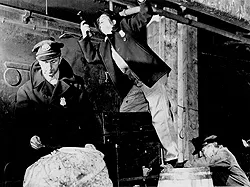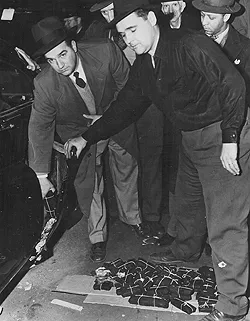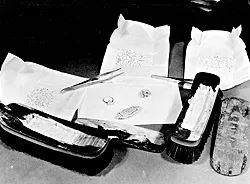On the morning of Feb. 15, 1951, Saul Chabot delivered his new two-door black Buick to New York City's Pier 90. Chabot, along with his coupe, was to set sail aboard the Europe-bound luxury liner R.M.S Queen Elizabeth. The duo never made the trip.

Division checking the Queen Elizabeth. (CBP historical collections, 1949)
That afternoon a U.S. Customs Service inspector was notified by a pier worker of a suspicious sag in the rear of Chabot's car. The fenders, upon tapping, sounded peculiar. Customs officers from the cargo division then dismantled the car- discovering 270 pounds of gold bullion worth $168,000 ($1.4 million in today's dollars) in specially built pockets inside the car's fenders. That evening, Chabot was arrested in his cabin and his vehicle seized for violating the Gold Reserve Act of 1934.
The law outlawed most private possession of gold coin, gold bullion and gold certificates, forcing individuals to sell it to the U.S. Department of the Treasury, after which it was stored in the U.S. Bullion Depository at Fort Knox, Ky., and other locations. Only those with "industrial, artistic, or professional" needs for possessing gold were granted licenses by the Federal government. Enter Salvatore Sollazzo.
Salvatore "Tarto" Sollazzo, a jewelry manufacturer, gambler, and former armed robbery convict, was living comfortably along New York's Central Park West. He owned two jewelry manufacturing firms, including one of the country's most successful manufacturers of wedding rings, and had recently married a young model. Business and personal life for Sollazzo was booming; however, by 1951 he was under investigation by a number of Federal agencies, including, the U.S. Bureau of Internal Revenue, the U.S. Secret Service, U.S. Immigration and Naturalization Service, and the U.S. Customs Service.

gold bars found concealed in the fender of Saul Chabot's vehicle. (CBP historical collections, 1951)
Only a few days before Chabot's car was seized, Sollazzo occupied a cell in the "the Tombs," more formally called the Manhattan House of Detention. He awaited trial on thirty charges of "offending against the peace and dignity of the people of the State of New York." Sollazzo had paid basketball players on the teams of Long Island University and the City College of New York to swing games on which he bet.
The black market in gold, which flourished in the U.S. from 1946 to 1951, was mostly maintained by jewelry manufacturers seeking to profit from a gold-for-diamonds smuggling racket between New York City and Europe. The jewelers did not do the smuggling themselves, but instead they merely supplied the gold to people, such as Cabot, who moved it on the jewelers' behalf. A variety of techniques were used to sneak gold and diamonds past Customs-false bottoms in luggage, handbags and shoes, hollowed-out books, jackets and undergarments with inner linings and false compartments in vehicles that were being shipped overseas.
Gold was distributed by the Bureau of the Mint, and the U.S. Secret Service would often investigate the recipients of gold licenses. In the case of Chabot, the Secret Service was more interested in his gold supplier. Each bar of gold sold by the Mint was stamped with a serial number, and on Chabot's bars the numbers had purposely been obliterated-though not completely, as investigation at the Mint laboratory revealed. Several bars of the seized gold had been issued to Francine Manufacturing Jewelers, Inc.-one of Sollazzo's jewelry firms. The Secret Service even located the tongs that had been used to hold the bars down while the numbers were eradicated.
In a period of about 20 days, Sollazzo may have set a record for running afoul the law. Only a week after his gold was seized by Customs on Feb. 23, 1951, the Bureau of Internal Revenue filed a $1.1 million tax lien against him. On Feb. 28, a Federal grand jury indicted him for tax frauds. On March 8, he was indicted in the basketball case, and on March 15, Sollazzo was served a warrant by INS calling for his deportation to Italy.
For his illegal trading in gold, Sollazzo was indicted along with 64 others on Jan. 8, 1952, and on March 13, 1953, he went to jail for his gold dealings and income-tax evasion. He owed the government more than $12,000 in fines and almost $1 million in back taxes and penalties. To finance his defense, Sollazzo mortgaged his jewelry firms, sold his personal property, and his wife's Cadillac. A broken man, Sollazzo pleaded guiltily to all charges.
He was sentenced to two years imprisonment and fined $10,000 for his gold dealings, on top of one year imprisonment and a $2,000 fine for his tax evasion.

broom handle, discovered by Customs
inspectors on board the Queen Elizabeth.
(CBP historical collections, 1949)
For bribing college basketball players, Sollazzo received an eight to 16 year sentence in the State of New York's Clinton Prison, at Dannemora.
The restrictions on gold ownership in the U.S. were repealed on Dec. 31, 1974, legalizing private ownership of gold coins, bars and certificates. Today, CBP continues the responsibility of enforcing Federal laws regulating trade, including gold. For more information on importing gold coins, medals, bullion as well as other items, visit CBP's Trade website.
The CBP History Program is interested in your history. Do you have a story to tell, a photograph or artifact to share? Contact us at CBPHistory@dhs.gov.

